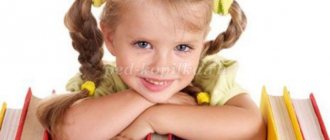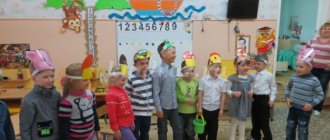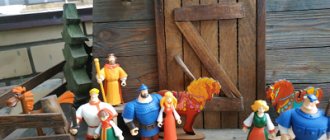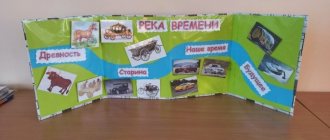"Russian folk tales"
Project work of 6th grade students
Topic: “Russian folk tales.” Creative title: “A fairy tale is a lie, but there is a hint in it, a lesson to good fellows!”
The fundamental question: “What is a fairy tale?”
Student research topics: “What types of fairy tales are divided into?”
I Problematic question: “When did fairy tales come into your life?”
Project goal: To develop creative thinking in participants, the ability to acquire knowledge from various sources, analyze facts, make generalizations, and develop general educational skills.
Formation of creative groups.
Design of projects (slides)
Group I. Fairy tales (Malaeva R)
Fairy tales are divided into magical, social and everyday tales and tales about animals.
Fairy tales involve people and fantastic creatures, and victory is achieved through sorcery.
There are many wonderful and extraordinary things in fantastic fairy tales. Good and evil wizards act in them: Baba Yaga, Koschey the Immortal, an airplane carpet, walking boots, a magic mirror and other creatures and objects endowed with supernatural powers.
In fairy tales, people can turn into animals, and animals and birds can speak human language. But these fairy tales are always based on phenomena of real life.
For example, in Morozko. Frost - The red nose gives wealth to the poor girl, the dog talks to her stepmother.
However, along with this, the fairy tale gives a truthful depiction of life, showing the relationship between stepmother and stepdaughter, which actually often happened in the old family.
The heroes of the fairy tale “The Frog Princess” are Vasilisa the Wise, transformed into a frog, and Ivan, the prince, with whom extraordinary adventures occur. But modesty, kindness and courage help Ivan, the prince, to overcome all obstacles and find his wife Vasilisa the Wise.
Positive heroes of fairy tales - Ivan the fool, Vasilisa the Wise, Marya Morevna, the youngest son and brother, the persecuted orphan, etc. etc.
Fantastic creatures act as enemies of the positive characters: the Serpent, Koschey, Dashing One-Eyed, the Sea King, Baba Yaga.
The conflict in a fairy tale develops with the help of wonderful, wonderful helpers (a horse, a frog, a kind old woman, a sorceress wife), wonderful objects (a purse - a self-shaker, a tablecloth - a self-assembly, a club - a self-breaker, a harp - a samogud, etc.)
Features that define the poetics of a fairy tale: verbal formulas, triple repetitions, slow-motion technique - retardation, constant epithets, saying, ending. A fairy tale is usually longer than other types of fairy tales.
The most popular fairy-tale stories are about the three princesses, about Sivka-Burka, about Koshchei the Immortal, about a boy and a witch, about a magic ring, about a stepmother and stepdaughter, about animal milk, about a frog princess.
In the wonderful fictions of fantastic fairy tales “Morozko”, “The Frog Princess”, “The Sea King and Vasilisa the Wise”, “Marya Morevna”, “Ivashka and the Witch”, “Sivka-Burko”, “Ivan the Tsarevich and the Miracle Yudo” and others, the people embodied dreams of a future fair, happy life, of free, interesting, facilitated human labor, and expressed confidence in the triumph of truth and goodness.
Project “Journey through Russian folk tales”
Municipal budget preschool institution
CRR kindergarten No. 51 “Rodnichok”, first category
Author:
Redhead Marina Vladimirovna, teacher
With. Kagalnik
2020 year
Why do we need fairy tales?
What does a person look for in them? Maybe kindness and affection. Maybe yesterday's snow. In a fairy tale, joy wins, A fairy tale teaches us to love...
Introduction
A fairy tale is a necessary element of a child’s spiritual life. Entering the world of miracles and magic, the child plunges into the depths of his soul. Russian folk tales, introducing children to the circle of extraordinary events and transformations that occur with their heroes, express deep moral ideas. They teach kindness towards people, show high feelings and aspirations. Meeting children with fairy tale heroes will not leave them indifferent. The desire to help a hero in trouble, to understand a fairy-tale situation - all this stimulates the child’s mental activity and develops interest in the subject. As a result of empathy, the child acquires not only new knowledge, but also, most importantly, a new emotional attitude towards the environment: people, objects, phenomena. From fairy tales, children draw a lot of knowledge: their first ideas about time and space, about the connection between man and nature, the objective world. Preschoolers are faced with such complex phenomena and feelings as life and death, love and hate; anger and compassion, betrayal and deceit. The form of depiction of these phenomena is special, fabulous, understandable to a child, and the height of the manifestations and the moral meaning remain genuine, “adults”. Therefore, the lessons that the fairy tale gives are lessons for life.
The project “Travels through Fairy Tales” is carried out as an exciting game, creative activity aimed at enhancing verbal, social and communicative communication. The integration approach allows you to develop in unity the child’s speech, creative abilities, communication skills, and emotional responsiveness.
Project passport
Project topic:
"Travels through fairy tales."
Project type:
long-term, creative, collective, with the participation of the students’ parents.
Project implementation period:
constantly.
Event location:
MBDOU kindergarten No. 51 “Rodnichok”,
Project participants:
children of senior preschool age, parents of preschool children, teachers
Target:
Introducing preschool children to folk culture through familiarization with Russian folk tales and small folklore forms.
Tasks:
1. Acquaintance with Russian folk tales 2. Expansion of vocabulary 3. Development of creative abilities
4. Ensuring the relationship between speech, theatrical, musical and artistic activities
Group II. Tales about animals. ()
From childhood, everyone is familiar with such fairy tales about animals as “Teremok”, or about a fox who, pretending to be dead, steals fish from a man’s cart, about a stupid wolf who, on the advice of a cunning fox, caught fish by lowering his tail into an ice hole.
If in fairy tales the storyteller narrates slowly about magical adventures, but the manner of fairy tales about animals changes. His voice seemed to disappear, but instead of his voice several new and very memorable ones appeared: “fat” - this is said by the bear, the owner of the forests; “sweet with cunning” is a fox. Lisa Patrikeevna, the fox's gossip; In a “thin” voice, the bunny – the little bunny – the little runaway conducts conversations. One of the fairy tales about animals is “The Crane and the Heron”
Project “Russian folk tales” in the preparatory group
Yana Sharova
Project “Russian folk tales” in the preparatory group
Project “ Russian folk tales ”
Project type : Short term
Project type : educational, creative, gaming.
Duration: 1 month
Project participants : children of the preparatory group , parents, teachers.
People have created wonderful fairy tales , songs, riddles, and sayings for children Works of folk art have not lost their impact on children today. The fairy tale speaks simply and convincingly about the victory of good over evil, truth over lies, and the triumph of justice. The positive hero of a fairy tale always wins .
Thanks to the fairy tale , the child learns and expresses his own attitude towards good and evil. Even children of older groups believe in fairy tales , which means that it is easier to teach and educate through it. Children learn to analyze and evaluate the behavior of characters, develop the ability to feel and understand others.
Project goal : To introduce children to Russian folk tales .
Tasks:
- to form children’s knowledge about Russian folk tales ;
- to cultivate a love for fairy tales , folk art , and artistic expression;
* teach children to evaluate the actions of heroes;
- develop speech, activate vocabulary;
-promote the development of joint creativity between parents and children;
- to arouse parents’ interest in life in a preschool educational institution and the desire to participate in it.
Project implementation stages :
Preparatory stage:
-change the subject-development environment in the group in accordance with the program;
-select exhibits to create a mini-museum of fairy tales ;
-organize an exhibition of drawings “ Fairy-tale heroes ”
by teachers, children and their parents;
-exhibition of books on Russian folk tales
- select Russian folk tales and illustrations for them ;
-reading Russian folk tales and then watching cartoons based on them;
- select coloring pages based on Russian folk tales ;
— find out from children and parents what books they read at home, whether there are fairy tales .
-ask parents and their children to take part in the production of books for the exhibition, and also to take part in the “Give a book to a kindergarten with an autograph”
.
Main stage:
Work with children:
1. presentations; conversations; conversation about rules of behavior using the plot of fairy tales ; watching cartoons based on fairy tales ; dramatization of fairy tales ;
showing fairy tales in tabletop theaters; showing fairy tales using a finger theater; reading fairy tales and discussing their content;
comparison of the content of fairy tales read and viewed; inventing other endings to fairy tales ; retelling of fairy tales ; telling a fairy tale using illustrations ; conducting a quiz on Russian folk tales and a quiz “Guess the fairy-tale hero ”
.applique; subject drawing.
Independent activities:
- coloring of coloring books;
- modeling of fairy-tale characters ;
Working with parents:
-participation of parents and children in the design of the book and drawings “Our Favorite Fairy Tales ”
;
— participation of parents in replenishing the puppet theater group ;
-participation of parents in the “Give a book with an autograph”
.
The final stage:
-creation of the “ Fairy Tales ”
;
- registration of drawings of children and parents in the book “ Fairy-Tale Heroes ”
;
- making a book based on fairy tales .
-An evening of entertainment viewing
fairy tales "The Magic World of Fairy Tales "
.
Planned result:
-development of interest in Russian folk art ;
— development of emotional responsiveness;
- the child’s positive attitude towards the world around him, other people and himself
Project “Folk tales as a means of introducing children to the life and culture of the Russian people”
Relevance.
How to make children love reading fiction. How to teach children to think and reason. When a child refuses to watch a cartoon and prefers a book. Only when he lives with the heroes, empathizes in difficulties and failures, and rejoices in happy moments. And raising children, the need for reading, the love of reading begins with a fairy tale.
A fairy tale is a favorable and indispensable source of moral education for children, since it reflects all of real life with evil and good, happiness and sorrow. It opens and explains to the child the life of society and nature, the world of human relationships, feelings and relationships. It develops the child’s thinking and imagination, enriches his emotions, and provides wonderful images of literary language.
The relevance of the program is due to the fact that its content forms social competence, promotes love for one’s native land, hard work, respect for people, and responsibility for all life on earth.
School-wide educational project “Folk tales as a means of introducing children to the life and culture of the Russian people”
a number of generally accepted areas of extracurricular activities are combined into one whole, namely:
· General cultural direction -
applied creativity with environmental and biological activities. It presents such types of arts and crafts as embroidery on cardboard (isothread), products made from salt dough and natural materials (cattail, birch bark), making folk dolls, primitive soft toys, paintings from wool, creating characters from Slavic mythology, drawing, modeling, etc. The project is designed to develop students’ professional skills, teach them to be thrifty, and prepare them for a confident entry into life in a modern economy. By independently making various crafts from used items and unnecessary decorations, thus giving things a “second” life, the children solve some material problems when purchasing gifts. Through creativity, children overcome their problems, realize their life experiences, affirm the positive in their lives, learn to create beautiful and useful things themselves, therefore the process of creating toys and crafts in any technique is no less important for a child than the result of his work.
· Spiritual and moral
A fairy tale enters a child’s life from a very early age, accompanies him throughout childhood and remains with him throughout his life. His acquaintance with the world of literature, with the world of human relationships and with the entire surrounding world in general begins with a fairy tale. Spiritual and moral concepts, vividly represented in the images of heroes, are reinforced in real life and relationships with loved ones, turning into moral standards that regulate the desires and actions of the child. The use of fairy tales for the formation of moral feelings and universal human values of preschool children is especially relevant at the present time, since in the conditions of the modern world there is a distortion of the original meaning of the works, turning the fairy-tale action from morally instructive into purely entertaining. Fairy tales have great potential for harmonizing the emotional sphere and correcting the behavior of a preschool child. The perception of fairy tales has a strong impact on the process of forming moral ideas, creates




